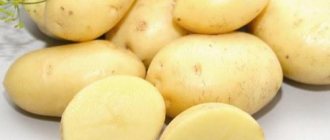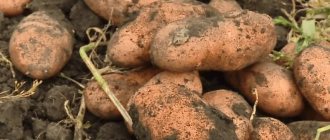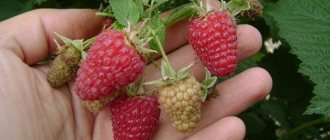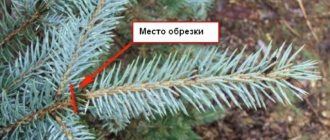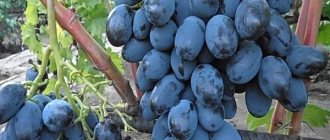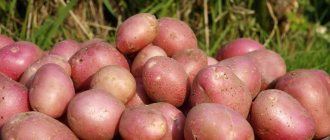Description and characteristics
Description of Colette's appearance
Potato tops are low. The leaves are medium-sized, with a wavy edge. The corolla of the flower is medium in size, reddish-lilac in color. Tubers are oblong in shape. The peel is thin, smooth to the touch, lemon-colored. The flesh is the same shade. The vegetable is distinguished by a low starch content, 12-15%. Therefore, potatoes do not darken when peeled and boiled. Does not lose shape during heat treatment. The weight of one potato is no more than 120 g, the eyes are small.
Landing dates
The planting time of this variety depends on the region of cultivation. In the southern regions, potatoes are planted in late April - early May. In the north and center of the country in mid or late May.
There are 3 conditions for starting agricultural work:
- Sufficient soil moisture.
- Its warming up.
- There is no threat of frost.
Potato ripening time
Colette is an early variety in terms of ripening time. Maturity occurs within 50-65 days after planting. Young potatoes begin to be eaten in mid-June. Technical maturity occurs 65-80 days after germination, after which the potatoes can be stored.
Potato harvest per hundred square meters
The yield of any crop depends on the area of cultivation. Fertile soils, good care and maturity of the tubers will increase the yield. After 1.5 months you can collect 110-130 kg per hundred square meters. When harvesting mature potatoes, the yield increases by 2 times. From one bush you can collect 10-12 tubers, weighing from 60 g to 125 g.
Taste qualities
In the rating of taste quality, the variety occupies the top line. Many dishes are prepared from Colette potatoes. When cooked, the pulp does not darken or become soft. Therefore, the variety is used to make chips and French fries, which always have a presentable appearance.
Colette potatoes are suitable for chips or French fries
Colette growing regions
Colette is actively cultivated in our country and neighboring countries. On fertile soils in the Central region and in the south of the country, you can harvest 2 crops per season. The variety is recommended for cultivation in the Middle Zone, Volga-Vyatka and North Caucasus regions. Cool and wet weather is not an obstacle to a good harvest.
Disease resistance
Colette potatoes have poor immunity to late blight. The variety is resistant to golden potato nematode and cancer. They note high resistance to blackleg, viruses A and Y. You can understand why potatoes are sick by reading the article about the signs of potato diseases.
Keeping quality of the Colette variety
You can preserve the harvest for a year, subject to storage conditions. The cellar or basement must have ventilation, the air temperature should not exceed +3◦. The quality preservation indicators of the variety are not lower than 92%, although these are early potatoes. To preserve the harvest until the end of spring, follow the recommendations from the article about harvesting and storing potatoes.
Possible diseases and how to deal with them
Colette potatoes are highly resistant to diseases and pests, but if care rules are not followed, this can lead to a number of negative consequences. Due to increased humidity, potatoes can develop late blight - a dangerous fungal disease that can lead to the death of potatoes. When the first signs are detected, the plants should be treated with fungicides. Pests such as wireworms, Colorado potato beetles, and potato moths are also dangerous for potatoes. Which have a very detrimental effect on the growth of the crop, and as a result on its productivity. If pests are detected, the plants must be treated as soon as possible with special chemicals.
Remember that it is better to prevent disease and treat seed material with specialized preparations before planting than to fight diseases and pests - which does not always end well.
How to increase potato yield
There are several known ways to increase potato yield:
- balanced plant nutrition;
- timely landing;
- use of sprouted tubers;
- planting at optimal soil temperatures;
- Irrigation of plants, timely weeding;
- use of plant protection products;
- appropriate crop rotation.
How to get two harvests in a season
Since Colette ripens very quickly, this allows for two harvests during the period from spring to autumn. Already in June you can harvest the first harvest, if you do not make mistakes during the growing process. A signal of complete ripening of potatoes is yellowing and complete drying of the tops. Harvesting can be done either manually or using harvesting equipment. This will speed up digging.
Preparing the area for the second planting involves loosening the soil, removing weeds, cultivating and moistening. After all these steps, you can plant the prepared and sprouted tubers. Preparing potatoes for planting is carried out in the same way as the first time.
Reviews about the variety
Alina, Podolsk
I’ve only planted a few rows of Colette, this is my second year, and I’ll say right away that the taste is not impressive. I like my boiled potatoes to be crumbly. I pour oil on top and sprinkle with herbs. This variety holds its shape, but tastes like soap. I grow it only for frying, but when fried it’s delicious, it’s not for nothing that it’s called a potato for chips.
Victor, Klin
I like Colette because it ripens quickly. 1.5 months after planting, almost all summer, we eat young potatoes. I can’t say that it is more productive than other varieties. Our plot is well fertilized, so we don’t have to take special care of it. In recent years, summers have not been very warm, but the variety consistently produces crops.
Advice from professionals
Agronomists recommend planting Coletta potatoes after the area has been grown with grasses, winter grains or legumes. If sand predominates in the soil, then lupine is considered a good predecessor of potatoes. In addition, most gardeners prefer to plant potatoes along with legumes. The varieties of crops planted, such as potatoes and beans, contribute to a good harvest.
In the process of crop growth, several growing seasons are distinguished, namely:
- before the first shoots appear;
- before the formation of the inflorescence;
- before the tops begin to yellow;
- the process of withering and drying of the tops.
During the first growing season, it is necessary to loosen the soil and remove weeds that interfere with the growth and development of the plant.
After planting, the area with planted potatoes must be harrowed, so that the weeds will slow down their growth and the soil will be saturated with oxygen. Such manipulations can be carried out every few days until seedlings emerge.
The next stage involves hilling the rows. Thanks to this, the root system will develop more intensively and tubers will form. Since the tops dry much later than the tubers ripen, it is recommended to cut them a few days before harvesting. This process will help dry out the soil surface and also make harvesting much easier.
Due to their high quality and properties, Collete potatoes are preferred to be grown not only on individual plots, but also on farms. The variety lends itself well to storage and lies in a shelter until spring; in addition, it tolerates transportation well.
Landing
Plant potatoes of the Colette variety when the soil has warmed up to + 3◦-+4◦. For better germination, pre-germinate the seeds. Treat the tubers with drugs that stimulate growth and disease resistance. For example: Prestige or Albit. The distance between rows should be 60-70 cm, between holes - 30-40 cm.
It is useful to put a handful of ash in each hole to feed and protect against wireworms. You can learn about the rules for planting potatoes here.
Advantages and Disadvantages of Culture
The Colette variety has a lot of advantages, for which it has received recognition and respect from experienced vegetable growers:
- early and simultaneous ripening of tubers;
- strong immunity and resistance to certain diseases;
- presentation and excellent taste of the product;
- long-term storage;
- the possibility of long-term cultivation in one area while maintaining varietal qualities.
See also
Characteristics and description of Uladar potato variety, planting and care rules
Read
Disadvantages include:
- high demands on soil;
- tendency to late blight;
- poor yield in dry and cold summers.
Note: Good predecessors for this variety are legumes, annual grasses and winter crops. The best predecessors include mustard. Colette does not need frequent changes of location: it grows well in one area for several years.
Care
Light, fertile soils will provide you with a good harvest. Try to use organic fertilizers annually on the site. It is imperative to weed and water the plants in a timely manner. The crop requires especially a lot of moisture during the period of budding, tuber setting and in a dry year. Hill up, like other varieties, 3 times per season. The first time is when the potatoes have just sprouted, the second time is before flowering, the third time is when you need to sprinkle the tubers with soil. Find out when is the best time to hill potatoes.
During the growing season, feed the crop with Nitrophoska 3 times. Remember that nitrogen ensures plant growth. Feed it in the spring, do not overdo it, excess fertilizer will lead to the growth of tops, not tubers.
Apply phosphate before and after setting tubers. Potassium is absorbed by potatoes throughout the growing season. From organic matter, it is better to use ash at the time of planting and throughout the season. Look what else gardeners feed potatoes with.
Pests and diseases
The variety is early ripening, so Colette is not threatened by most fungal and viral diseases. Potatoes may be damaged by late blight. This usually happens when planting a crop for the second time in a season. For prevention, planting material is disinfected with boric acid and manganese, and at the first signs of disease it is sprayed with Penncozeb.
Among insects, the Colorado potato beetle parasitizes potatoes and poses the main threat from the beginning of the growing season to the end of flowering. Pest larvae are collected manually or the plants are treated with Tyrant.
Harvesting
The timing of potato harvesting varies depending on the growing region. After 1.5 months it can be eaten. Remove for storage when the tops are dry. When signs of late blight appear before harvesting, it is better to trim the stems so that the tubers do not get sick.
Harvest potatoes in dry weather, preferably by hand. The potato skin is very thin, try not to damage it. Let it dry well and lie in the sun.
The seeds are greened before being stored in the cellar. Sort the tubers by size, quality and storage. The room temperature should be no higher than +3◦, air humidity 80%. How to properly store potatoes can be found here.
Growing Colette
Colette is planted early. Planting dates depend on the region in which this variety is grown. In the southern regions, seeds are sown at the end of April. However, there is no need to rush to disembark. The simple truth is: not only late planting, but also early planting can lead to a decrease in yield.
For such early potatoes, you need to choose areas with light loamy or sandy loam. The place should be well lit by the sun and cleared of snow quickly. By the day of planting, the air temperature should remain at least 10 degrees. The soil should also warm up well, be well moistened and fertilized.
It is better to start preparing for planting potatoes in the fall. Before wintering, the soil must be dug deep. This is done in order to draw out all the pests and their larvae, as well as to collect the remains of herbs that can be carriers of diseases. Winter temperatures will kill all potential pests, and by spring you will have healthy soil ready to accept a new crop.
During spring digging, compost soil is added to the soil (stale manure is possible). Do not forget about adding mineral components (superphosphate) and potassium compounds. Be sure to apply nitrogen fertilizers (ammonium nitrate, ammonium sulfate or urea), which at first will promote intensive growth of stems and leaves.
Where to plant Colette
It is recommended to plant this variety in places where winter crops, annual grasses, legumes and flax previously grew. You can plant potatoes together with “favorable” neighbors, such as beans. It has been proven that when these crops grow nearby, they produce better yields.
Fact: this variety can be planted in the same place for several years in a row and not worry about a decrease in the quality of the potatoes.
Seed preparation
To get a fairly mature harvest by July, it is better to plant sprouted potatoes. It is germinated well in advance of planting. Around February-March, seed potatoes are laid out in a thin layer in boxes or on the floor in a warm and bright place.
For planting, it is better to select medium-sized tubers weighing 80 grams. If larger specimens are found, they are cut in half. It is necessary to germinate tubers in a humid climate. To do this, many gardeners create a greenhouse effect by placing the tubers in a mixture of soil and sawdust and adding a little water. The boxes are covered with film and left until sprouts appear. As soon as the eyes hatch, the film is removed and the potatoes are left to grow further until planting.
Tip: to save space, you can also germinate seeds in plastic bags, after making small holes in the bottom, otherwise the potatoes will suffocate. The bags can be hung in a slightly shaded place. With even lighting and moderate heat, the sprouts on the tubers grow strong and thick.
If there are no conditions for germinating potatoes, then you can plant ordinary seeds. However, it is useful to keep such tubers for at least 10 days in a room with a temperature above 15 degrees Celsius. This way the potatoes will warm up well, their eyes will wake up faster and quickly begin to grow in the ground.
Before planting, the planted material is treated with disinfectants and growth stimulating agents. For these purposes, you can use copper sulfate, manganese solution, as well as such preparations as “Prestige”, “Cruiser”, “Force”, “.
You can also sprinkle the seeds with wood ash, the benefit of which is to improve the growth and development of plants in general. It will not be worse if well-warmed tubers are fed with minerals in the form of a mixture of ammonium nitrate and superphosphate. Vitamins will give the tubers greater vitality.
Planting potatoes
The finished plot with lush, loose and semi-moist soil (necessarily well heated) is usually divided into rows, which makes it easier to plant potatoes and subsequently care for them.
You may be interested in: Dates for planting potatoes in May-June 2021 according to the lunar planting calendar Favorable days for planting potatoes in 2021 according to the lunar calendar Dates for planting potatoes in 2021 for central Russia and the Moscow region
The holes are made 5-10 centimeters deep. Grown seeds are planted to a depth of 5 centimeters, others - deeper. Place the potatoes with the sprouts up and cover them with soil, but not to the full depth, but 3-5 centimeters. If the tubers were not previously sprinkled with ash, you can apply the fertilizer directly into the holes. The recommended distance between potato bushes is 35 centimeters. The row spacing is left 60 centimeters wide.
Under favorable climatic conditions and well-fertilized soil, the first shoots appear very quickly, on the 7th day.
Care
The Colette variety is so popular among gardeners and industrialists because of its ability to produce consistently high yields and excellent appearance. However, to grow such potatoes you need to work hard. When cultivating the variety, you should pay special attention to the composition of the soil, because Colette can give good results only on fertile lands. It also reacts strongly to a lack of water, especially during periods of flowering and budding.
Basic techniques for caring for Colette:
- Hilling - carried out 3 times per season. The first time immediately after the first shoots appear. This will help stimulate rapid growth of stems. Subsequent hillings are carried out at intervals of two to three weeks. It is preferable to perform the procedure immediately after rain or watering; this will help shake the soil and improve gas exchange. During the first hilling, you can completely cover the sprouts with soil, so the young shoots will be reliably protected from the May night frosts.
Important: with the help of hilling, a larger area of land receives nutrition faster.
- Loosening the soil, weeding. Loosening is carried out immediately after planting, without waiting for the first shoots to appear. This agricultural technique allows air to better penetrate the soil and improve root development. At first, it is better to loosen superficially so as not to pull the seeds out. After the bushes grow, deep loosening is carried out, which provokes sufficient soil moisture. Loosening helps get rid of weeds, breaks up the dry crust that has formed on the ground, and promotes the development of buds and tubers.
- Watering is carried out in a timely manner, only when the weather is hot and dry for several days. The soil should always remain moist, but not wet, otherwise fungus may appear on the plants. Water is very necessary for sprouts in the first stages, when it is important to lay a strong foundation for the future bush. Over time, during the formation of buds and the beginning of flowering, when tubers are intensively laid, the abundance of moisture and nutrition will contribute to the proper growth of stolons and the laying of tubers.
Important: well-drained soil promotes better gas exchange and allows moisture to pass through well.
- Feeding is carried out 2-3 times per season. It is better to apply all the fertilizers before flowering begins. Among the preparations, gardeners often choose Nitrophozka, Mortar or Effecton. The appearance of the plants can indicate the need for fertilizer. If the stems develop poorly, they are thin and limp, and the bush as a whole grows frail, then fertilizing is required. Plants require a second feeding at the budding stage. It is carried out using ash and potassium sulfate. The last application of fertilizers comes down to the flowering period. They use drugs such as Effekton and superphosphate.
Tip: it is important to periodically spray the bushes against the Colorado potato beetle.
Diseases and pests
The variety is resistant to many types of diseases. Diseases such as potato cancer and golden cyst nematode are not scary for him.
However, roots and tubers can be affected by late blight and isolates.
As soon as the appearance of the plants begins to signal the development of any disease or pests appear on the stems, the plants should be treated with effective means, for example, Albit, Polyram, Kurzat, Hom and Ordan. During the growing season, you can also spray the bushes with Kuproksat with a working fluid flow rate of 400 l/ha.
Methods for propagating Colette potatoes
Most summer residents propagate potatoes by planting tubers. Other methods are no less well known. You can grow potatoes by dividing the tubers. To do this, take a large potato, cut off the apical eyes along with the pulp and plant them in sawdust. Cover the tubers without apical eyes with soil, cut side up. The other eyes will now begin to wake up. After a week, divide the tubers into parts according to the number of eyes and plant them in a permanent place.
There is a method of propagation by sprouts that appear on seed potatoes. Carefully break off the sprouts; you can even divide them into several parts. It is important that each has 2 buds. Plant the sprouts in boxes and water them. Plant in a permanent location when the weather is favorable.
It can also be propagated by cuttings. To do this, choose the most powerful bushes and cut off strong branches from them. Remove excess foliage and tops, leaving one leaf with a bud. Disinfect the cuttings with a weak solution of manganese. In a horizontal position, sprinkle it with soil, leaf side up, and water it. In a month, tubers will appear on the cuttings.
The culture is propagated by seeds. To do this, do not dig up several bushes during harvesting. There are seeds in green boxes, let them dry and store them. In February, sow and water the planting material. After 2 weeks, sprouts will appear. 45 days after this, the crop can be planted in the ground.
The most popular methods of growing crops are propagation by eyes and peel. Cut out the sleeping eyes and plant them in a box with soil, water them. When their height has reached 10 cm, the air temperature is + 10°, they can be planted in the garden. Cut the peel thicker, do not disturb the eyes. Do the rest by analogy.
How to care?
When caring for Colette potatoes, it is recommended to follow the watering regime. Root crops love moisture, but you shouldn’t over-water the beds. Do 2 approaches per month. For young potatoes, the volume of liquid is 5 liters per bush. For adult root vegetables – 12 liters. The soil should form a ball when compressed.
With reduced humidity, tubers develop poorly. If waterlogged, they can rot. Nutrients are washed out of the pulp, but to the credit of the breeders, the root crops are not prone to cracking.
To maintain constant soil moisture, mulch the beds with peat or straw. The mulch must be turned over. The soil is loosened.
Otherwise, rodents and insects may live in the straw or peat. Watering is carried out over mulch. When introducing root feeding, the straw is moved away from the bush.
Colette potatoes usually do not require fertilizing. If the soil was prepared in advance, according to all the rules, then it contains enough nutrients for the normal development of root crops.
During the period of intensive growth, plants can be supported with a weed solution with the addition of pine needles, yeast, and mineral fertilizers.
Fertilizers are used only as indicated if the color of the tops changes. Mineral fertilizers are necessary if the stems become thin and develop poorly. You need to be careful when analyzing changes in the tops in order to notice an infectious disease in time.
If the weather in spring is cool, 18-20 C, and it rains often, then brown spots may appear on the leaves and stems. A fluffy coating appears along the border of the spots.
These are signs of late blight; the plaque consists of zoospores. At the first symptoms of infection, it is recommended to treat plants with Fitosporin. Plants are sprayed. Repeated treatment is done after 10 days.
If late blight appears on adult plants, then you can use Bordeaux mixture or copper sulfate. In European countries, the fungicide "Shirlan" is used. It is also available on Russian markets.
The advantage of this drug is that it not only destroys zoospores, but also helps restore the plant’s connective tissue
It is very important to notice the first signs of late blight in order to carry out prevention in time. Otherwise, the infection can destroy all plants:
- young shoots begin to appear 3-4 weeks after planting the potatoes. After another 2 weeks, hilling is carried out. By this time the bush has risen to 12-15 cm. Young plants can be treated with Fitosporin to prevent the development of fungal infections;
- after 3 weeks, another hilling is carried out. After work, the bushes can be sprayed with a solution of boric acid, 5 g/10 l. Acid is a good antiseptic. It can be used after a cycle of precipitation or after strong winds; weather conditions are favorable for the development of mosaic and powdery mildew. According to plant growers, iodine solution, 5 ml/10 l, helps well against infections;
- The bushes are sprinkled 3 times during the flowering period. Cover the stems to half their height. During this period, intensive growth of stems and stolons occurs. It is recommended to spray or fertilize with preparations that increase the yield of root crops. These include “Zdraven”, 15 g/10 l, “Zircon”, 1.5 ml/l; 50 ml of solution is poured under the bush. Well improves potato immunity and improves productivity “Potassium humates”, 100 ml/10 l.
For insects, gardeners use an infusion of pine needles or onion peels, but they only repel pests. To kill insects, chemicals are used: “Fufanon”, “Prestige”, “Decis”. Treatment is carried out 2 times with an interval of 2 weeks. They irrigate both the bushes and the soil.
The last time insecticides are used is 3 weeks before harvesting. At the same time, all work stops. Potatoes are no longer watered or fertilized.
If potatoes are planted in mid-May, then young potatoes can be dug up at the end of July. It must be cleaned of dirt, dried and placed in a dark and cool room.
Since root vegetables are intended for quick use, treatment with antiseptic agents may not be necessary. The storage facility is pre-cleaned, ventilated, and all surfaces are treated with slaked lime. Ventilation is established in it.
